
Steamboat Paintings - Modern Art
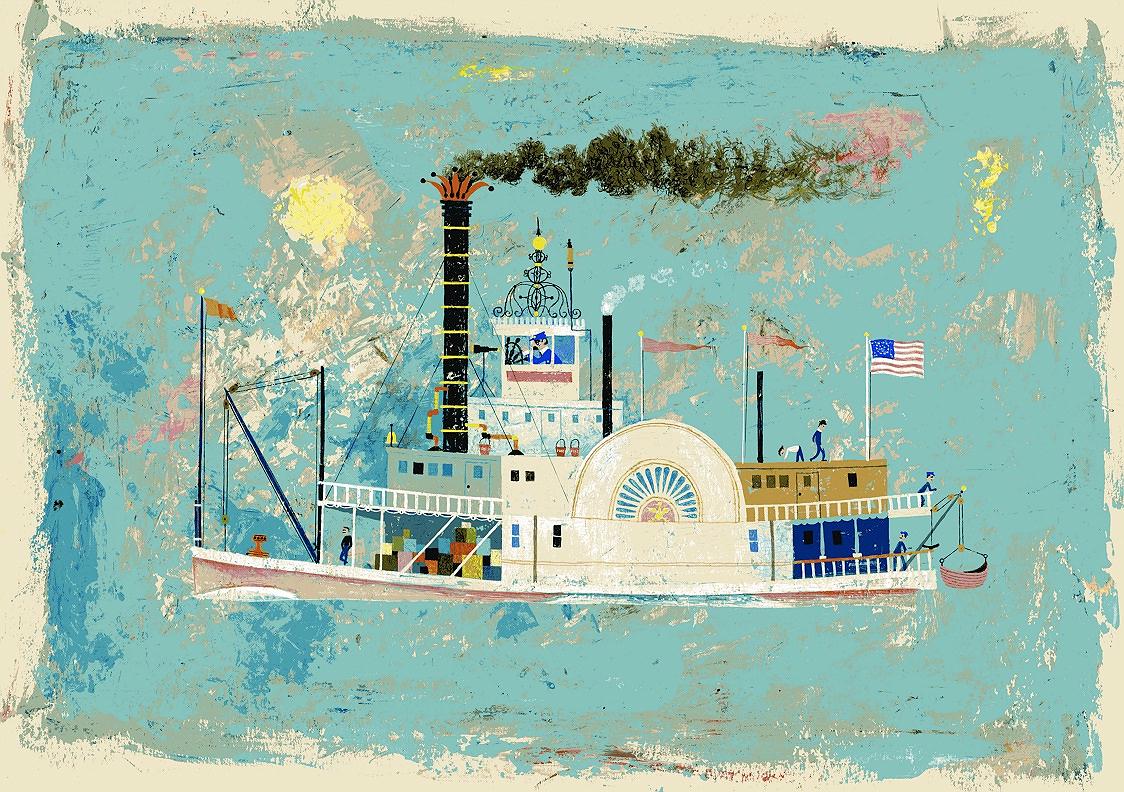
Painting by Cal Sacks RR2 Westport, Conn. A book search revealed that Sacks had illustrated anthologies in the '60's for editor Walter B. Gibson, on 3 nefarious subjects: The Fine Art (of Swindling), also (of Spying) and (of Murder). Sacks also did illustrations for at least 3 other books on quite different subjects: The South Seas, Earthquakes and California Wines.
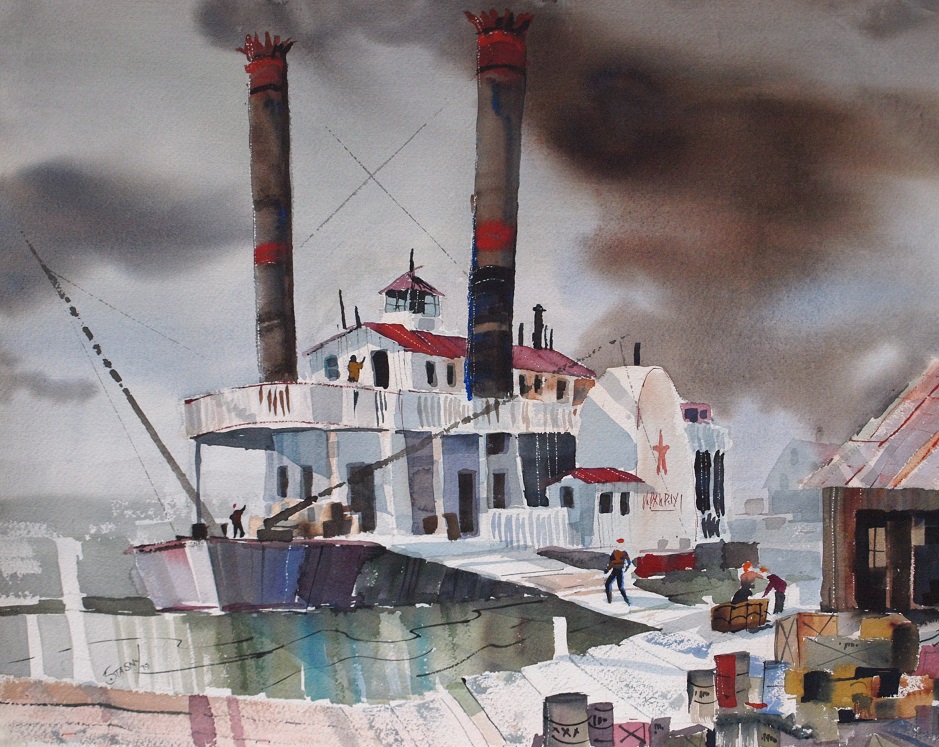
Artist: Harold Stasny 1979
'Riverboat' - Full Sheet
22" high x 30" wide
Can't tell if this was done "on location," from memory or just "imagined." Reminds me vaguely of a lighthouse tender that was turned into a Haunted House to frighten visitors during October & Halloween. The pilot house is not really big enough and the roof of the "Texas" cabin under the pilot house has a "peak" like a "landlubber's" building but there's some interesting atmosphere and technique going on in the painting itself. The dealer I bought this from said that there were indications that Harold Stasny may at one time have been an art instructor at a Louisiana university.
The name on the paddlebox from what I can make out looks like nonsense, something like: PxhPJY probably just improvised to simulate a name without being actual words.
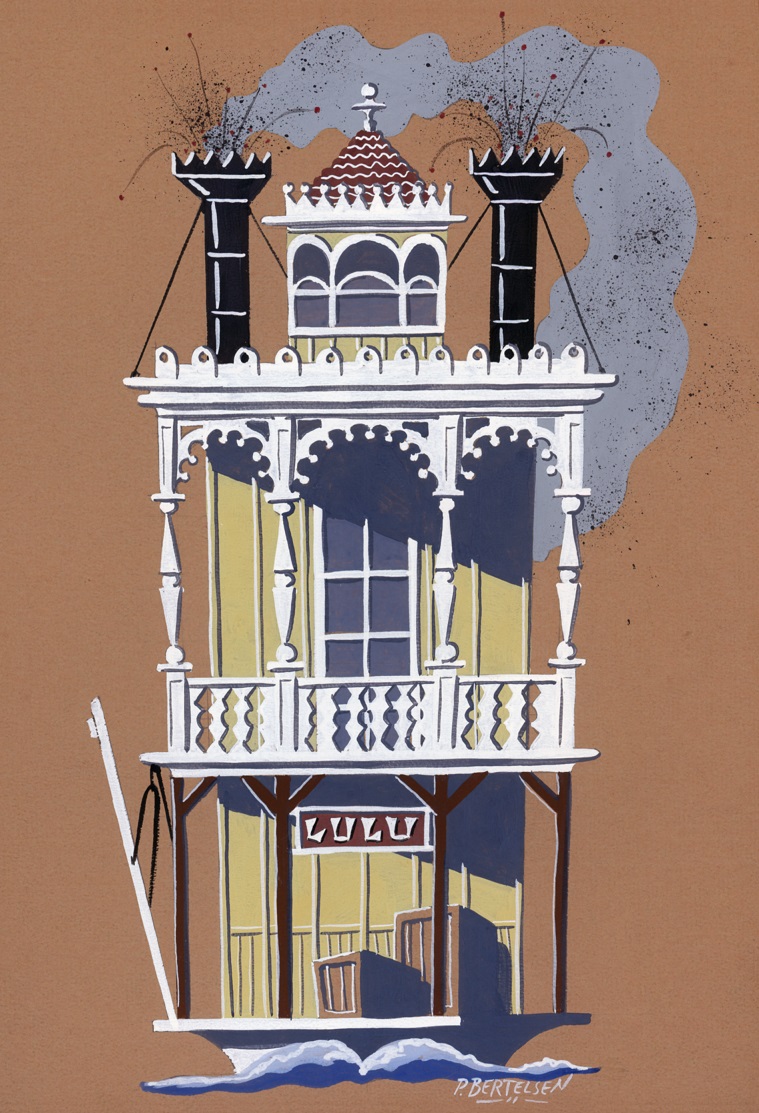
"LULU" by P. Betelsen
Quaint and curious 1950's (?) whimsical spin on a riverboat that artist "P. Betelsen" named LULU. Painted on 9 x 12 textured medium brown board with poster paint.
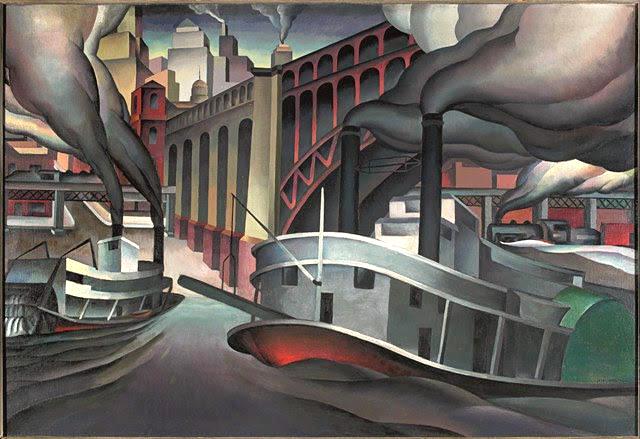
Beautiful cubist influenced painting by St. Louis artist Joe Jones of steamboats and the Eads Bridge:
River Front (Saint Louis Levee) 1932
40 x 60 inches Oil on canvas
Joe Jones From the Collection of Rex and Jeanne Sinquefield
slu.edu
Only 54 when he died, Jones managed to accomplish an incredible amount of art and influence in his relatively brief 5 and and a half decades.
He gravitated away from St. Louis to New York City and the artists and political awareness there.
During one of his last visits to St. Louis Jones concluded:
"The people stand off, convinced sufficiently but without enough courage to follow their own conviction. And still that other thing exists, indifference."
This St. Louis Art Museum online documentary is very informative . . . see link below:
Joe Jones:
Painter of the American Scene
youtube
Produced in conjunction with the Museum's 2010 exhibition entitled Joe Jones: Painter of the American Scene, this video explores the life of the extraordinary artist Joe Jones and his connections to St. Louis of the 1920s and '30s. The video features interviews with the artist's children, insights from exhibition curator Andrew Walker, and comments on Jones's work by art historians. Archival photos of St. Louis locations that played a role in the early work of the artist, as well as historic pictures of Jones and his family and friends make the film visually compelling. This film received a mid-America Emmy for directing in October 2011.
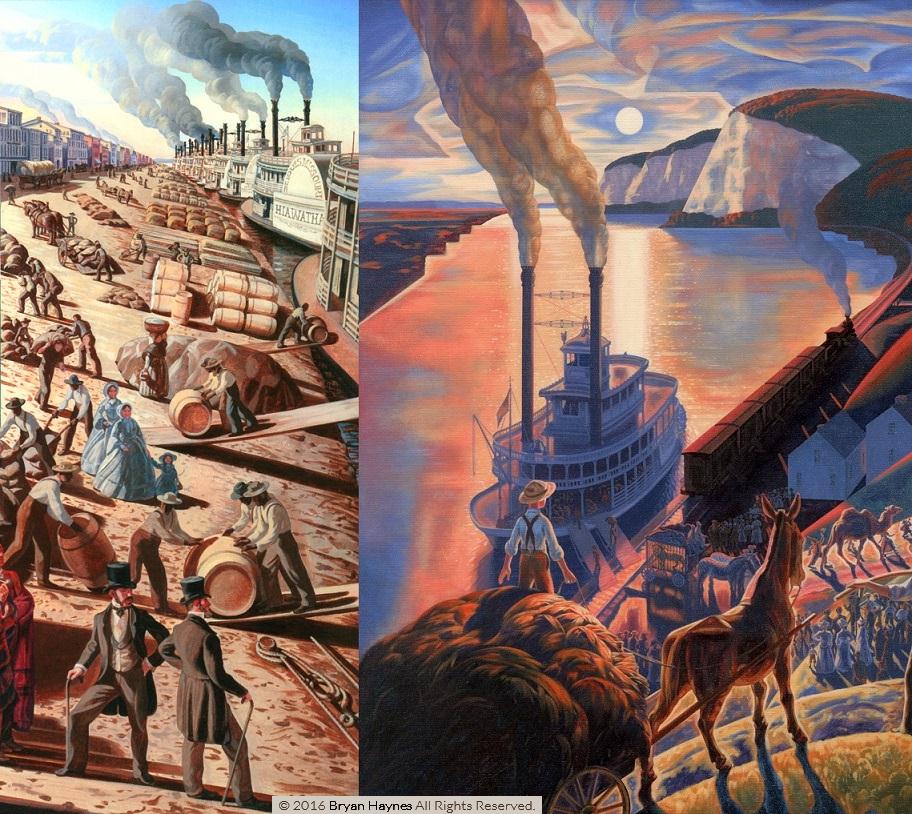
On the RIGHT is a detail from Missouri artist Bryan Haynes' painting of a circus unloading from a steamboat and a train. Performers and diverse animals form a parade that is marching up to the top of the hill where the tents for the circus are waiting for them above an unnamed Mississippi River town.
Bryan's 2013 art book of his NEW REGIONALISM work is beautiful and features the detail on the LEFT from his 2010 Gateway Arch mural which includes an atmospheric depiction of the Mississippi River landing at St. Louis, Missouri crowded with steamboats during the 1850s.
Two sizes of prints on canvas of the the Circus painting and other works as well as his book are available directly from Bryan via his website:
artbybryanhaynes.com
His book:
NEW REGIONALISM: THE ART OF BRYAN HAYNES
Published in 2013, the hardcover, 12 x 12 inch
204 pages presenting over 225 color illustrations.
Two different sizes of prints available on canvas:
ARRIVAL OF THE CIRCUS
In the nineteenth century a circus might arrive at a village on the Mississippi both by steamboat and by rail.
In the video at the following link Bryan shares his work and inspiration:
"Mural Artist - Bryan Haynes | School of Fine Arts | Academy of Art University"
Bryan Haynes shares images of his work throughout his career as an illustrator and mural artist.
Yahoo.com video
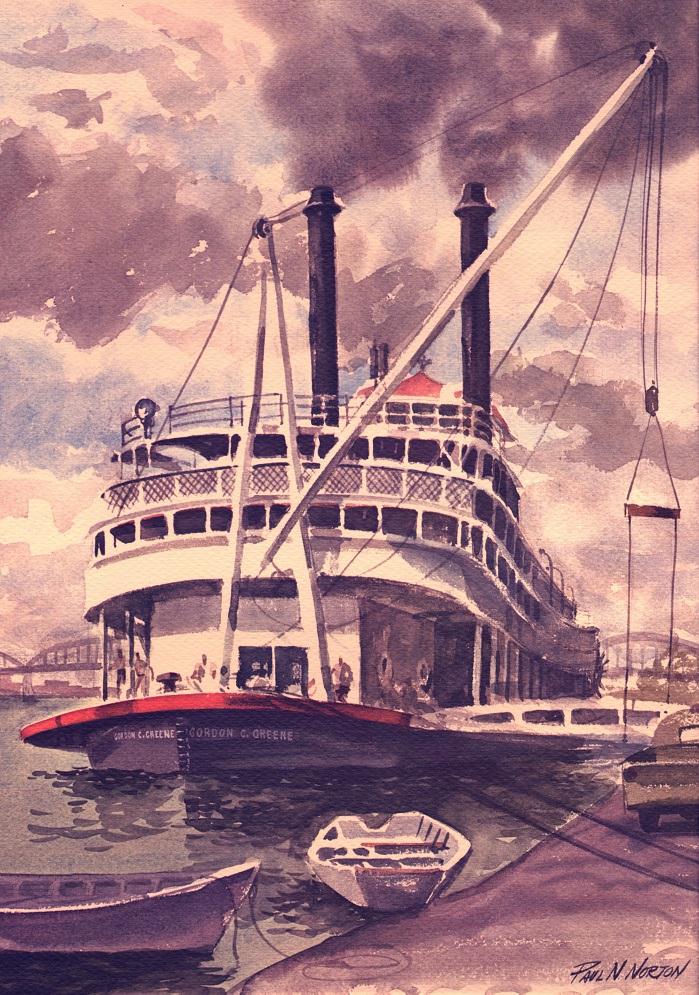
Watercolor by Paul N. Norton of the GORDON C. GREENE
Scan of a 14 x 19 inch reproduction on watercolor paper of Paul N. Norton's painting of the GORDON C. GREENE. The last "E" in GREENE was missing from the names on the bow so I replaced them in Photoshop.
https://en.wikipedia.org/wiki/Paul_Norton
Paul N. Norton (February 15, 1909 in Moline, Illinois - 1984) was an American artist who painted more than 500 watercolors in his career.
He primarily painted subjects near and dear to himself and the fellow residents of the Midwestern Quad Cities, five cities in northwest Illinois and southeastern Iowa: Davenport and Bettendorf in Iowa, and Rock Island, Moline, and East Moline in Illinois - local historic landmarks, churches, schools, and parks. His greatest gift was in capturing the essence of life in communities on the Mississippi River, and his legacy lives on in his art that is enjoyed throughout the world to this day. Norton's most popular works include paintings of the passenger steamboat DELTA QUEEN, the towboat LONE STAR and the ferry W.J. QUINLAN.
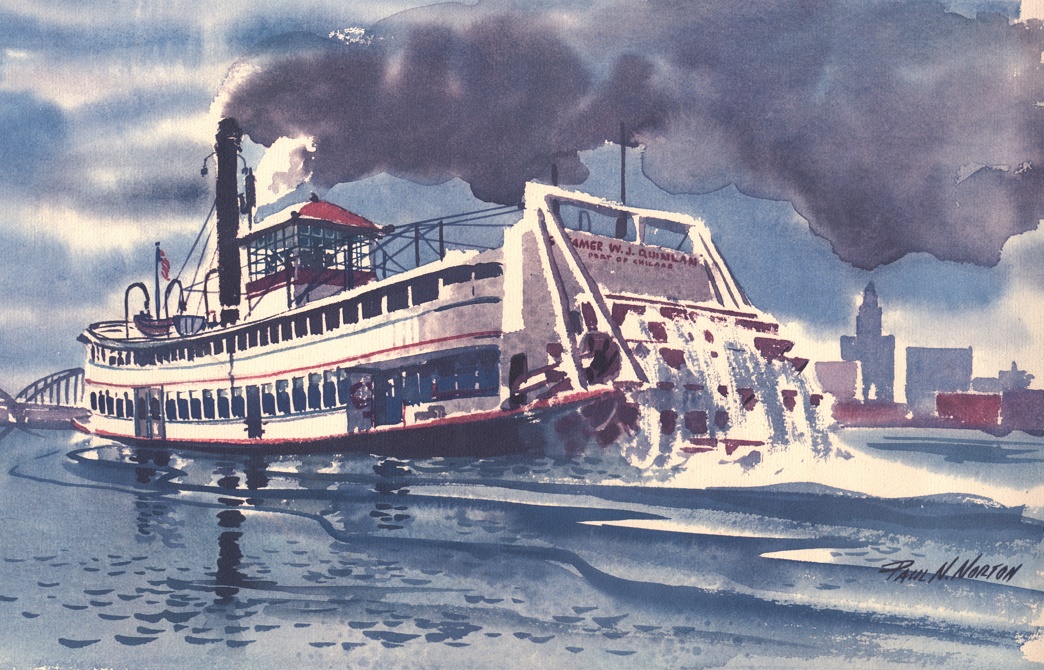
Paul N. Norton's 1954 watercolor painting of the ferry W.J. QUINLAN
Print of Paul N. Norton's watercolor painting of the ferry W.J. QUINLAN. Caption edited from Davenport Library's Special Collections blog from 2009
Riverboats We Have Known: The W.J. Quinlan
Posted on June 1, 2009
by Special Collections blogger
DAVENPORT, IOWA
Public Library
http://blogs.davenportlibrary.com/sc/2009/06/01/riverboats-we-have-known-the-wj-quinlan/
When one thinks of past Davenport ferryboats, the one that usually comes to mind is the W. J. QUINLAN. This beautiful steam-powered stern wheeler, built in 1904 by the Kahlke boat works in Rock Island, Illinois, was originally named the DAVENPORT.
In 1925, William J. Quinlan bought the boat, refurbished her, and renamed her after himself. The QUINLAN carried businessmen, shoppers, sightseers, and children between Rock Island and Davenport during the day, and offered night tours of the river—plus the use of its dance floor and casino—to couples and gamblers.
After decades of active service, never venturing more than two miles from where she was built, the QUINLAN developed structural problems in her hull, and retired to the Kahlke yard in 1946. The QUINLAN was lost in a dry dock fire in April of 1967.
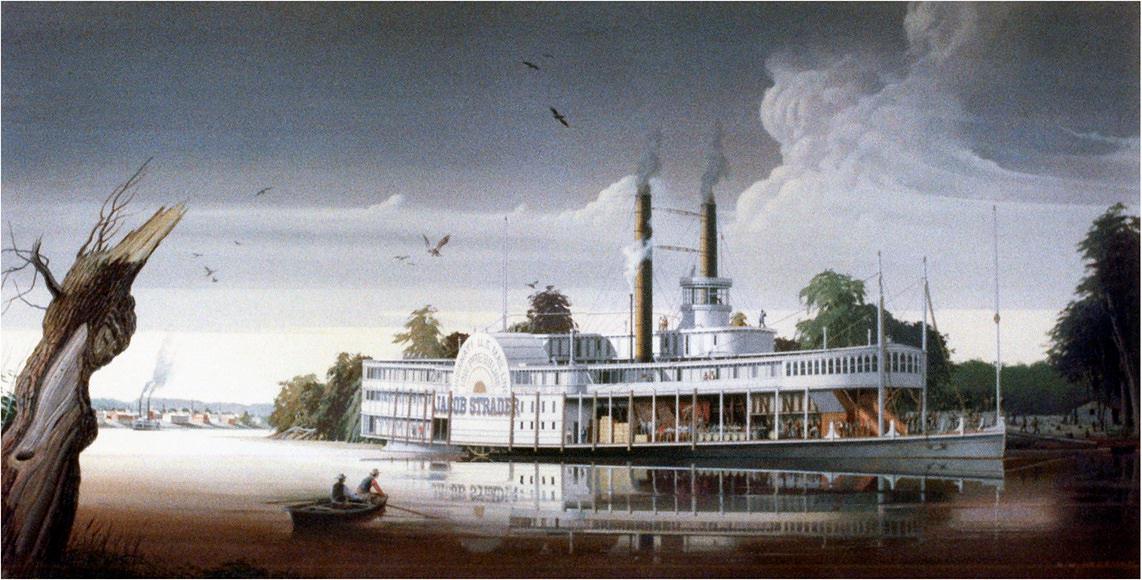
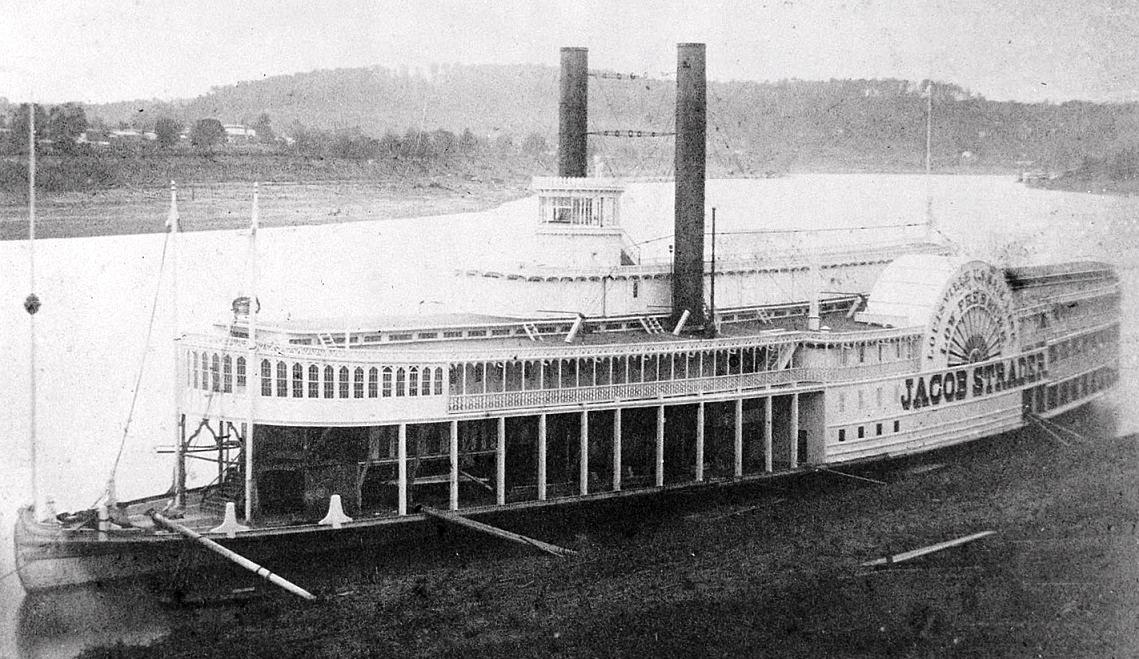
Here is an extraordinary painting by artist Robert Hegeman which was published in black in white in an issue of the S&D Reflector. I wrote to Bob back in the 80's and he kindly sent me a color slide of the painting from which this print was made. Bob also sent some beautiful black and white prints made from his expert pen and ink drawings of a number of classic steamboats. Bob's style is classical in the tradition of European masters and also evocative of John James Audubon who was born into a French Colonial family in Santa Domingo which is now Haiti in 1785. Audubon's paintings of birds and mammals often included landscapes in the background in a style similar to Bob Hagemann's.
The JACOB STRADER was out of the ordinary in style with a cylindrical-shaped pilot house and smokestacks aft of the pilot house instead of ahead of it. Also the front of the boiler deck enclosed with formal windows was unusual and anticipated how the CAPE GIRARDEAU's boiler deck would be entirely glazed in during her dozen year reign beginning in 1923 and and ending in 1935 when she became the GORDON C. GREENE. When the 1914 vintage IDLEWILD became the AVALON in 1948 she was given a similar window treatment in a less formal style. Attached plumbed, cropped and resized photo of the STRADER from the La Crosse collection which proves that her rather fantastical appearance was accurately depicted by Bob.
JACOB STRADER (1853-1866)
Sidewheel Packet
Way's Packet Directory Number 2915
Built 1853 at Cincinnati, Ohio which was also her first home port.
Owned by the U.S. Mail Line Company
She ran Cincinnati-Louisville, entering the trade on June 7, 1853.
Captain John Blair Summons (master); Captain Charles Dittman (master, pilot); Captain David Whitten (master) Ohio; Tennessee; Kanawha and Mississippi rivers
The STRADER had "low pressure" machinery and advertised as such to assuage the fears of those who were leery of the high pressure engines of those days. During the early part of the Civil War she was often used to convey wounded and sick soldiers as her cabin was 306 feet long with 310 available berths.
She was dismantled at Madison, Indiana in July 1866 and her machinery went into the construction of the steamer RICHMOND.
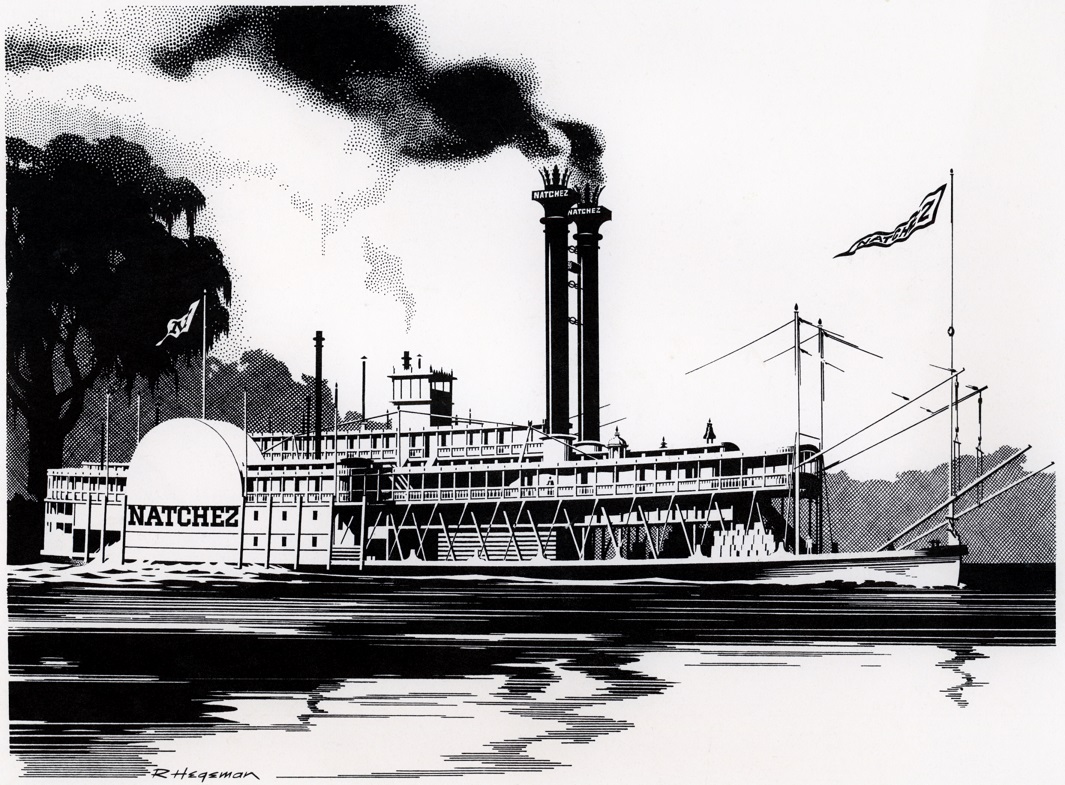
Pen & Ink of the racer NATCHEZ by Robert Hegeman.
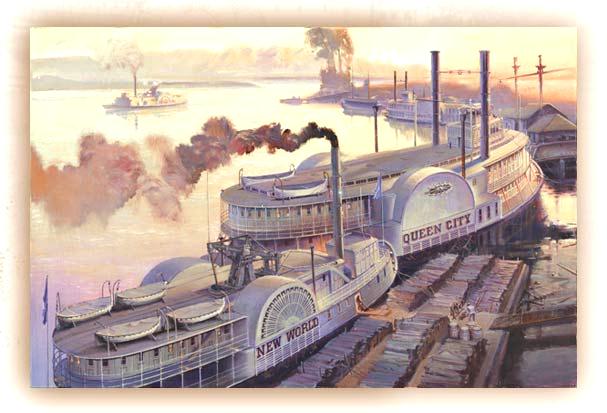
Sacramento River steamboats in a painting by Park Merrill
Exceptional, beautiful painting of a vintage Sacramento River scene by Park Merrill. Hope that a print of this painting with the steamboats New World, Queen City, Lady Adams, Helen Hensley and Senator will eventually become available. A truly memorable work of art.
sachistoryart.com
SACRAMENTO HISTORICAL ART
Paddle Wheel Days
Capturing the excitement and bustle of Sacramento's embarcadero in the 1850s, this nautical portrait - constructed from early photos and actual on-the-spot drawings - features some of the real-life illustrious steamboats of the day.
Here in the forefront, at the foot of H though K Streets, workers attend to the New World, a walking-beam paddlewheel that was stolen from the East Coast and sailed around Cape Horn. When word reached Sacramento that she carried the deadly cholera disease on board, many people evacuated the town.
Other steamers crowd the dock. Just beyond the Queen City is the Lady Adams, followed by the Helen Hensley - all vessels that offered regular transportation between San Francisco and Sacramento. Out on the Sacramento River in the distance, the Senator is seen flowing downstream.
About the Artist, Park Merrill
Park Merrill, a native Californian, was born in Fortuna, Humboldt County, in 1938. From an early age, Merrill showed signs of an artistic nature.
After high school, Merrill attended Humboldt State College for a year and a half, taking many art courses. Wanting a more intensive art education, he attended the four-year professional art school, Art Center College of Design, located in Los Angeles at that time. Art Center is one of the three most prestigious art schools in the country.
After graduating from Art Center in 1963, Merrill worked as an illustrator and graphic artist, ending his career with 27 years at Lockheed Missiles & Space Company in Sunnyvale. During that time he painted conceptual designs for satellite systems and other high-tech space programs such as Star Wars, Space Station Freedom, and the Hubble Space Telescope.
Since his retirement, Merrill has developed his fine art skills and a style he calls "Soft Impressions of California." These images are from California's colorful past and present. Painted in oil, they combine pastel colors with soft edges. "This has been the most exciting work I have done to date," says Merrill and it is his hope that the art-viewing public will agree.
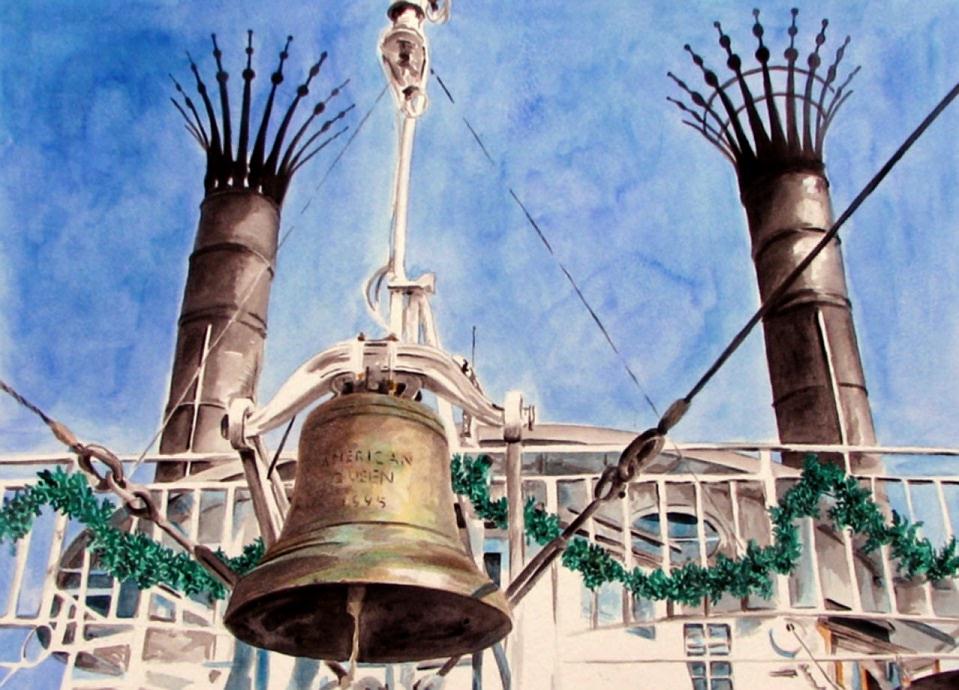
AMERICAN QUEEN bell and stacks painted by Su Stella
Prints of this painting were being sold by the artist Su Stella a while back on ETSY. It's a pleasing image of the AMERICAN QUEEN's bell and stacks. The "pine garlands" suggest the occasion was during November/December, leading up to Christmas. [Copyright Su Stella].
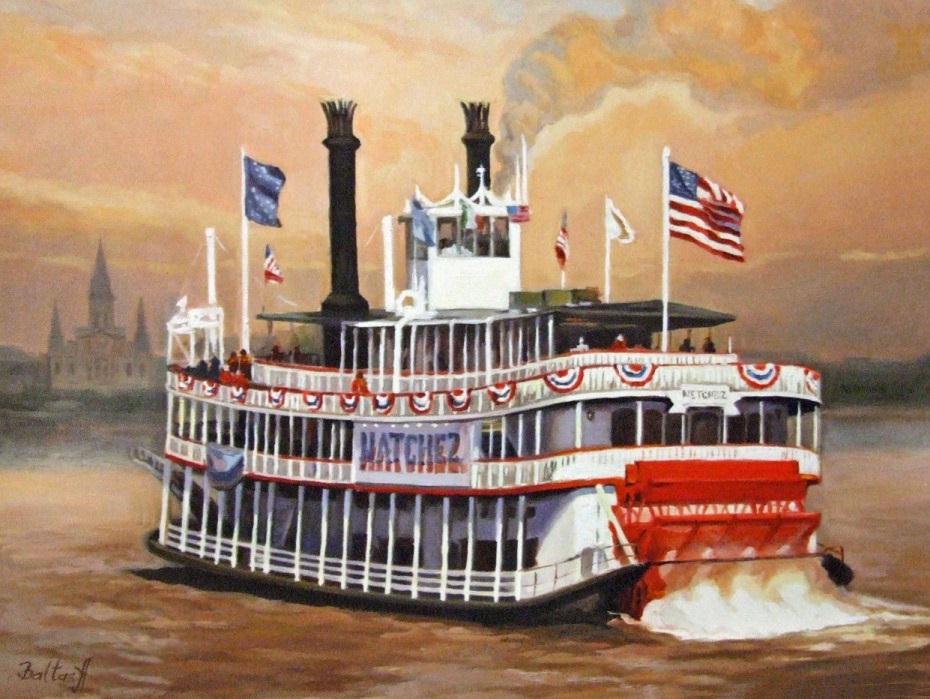
Modern NATCHEZ steamboat at New Orleans by Alla Golets
A pleasing Impressionist style painting of the "modern" steamboat NATCHEZ at New Orleans by Alla Golets Baltas
Alla Golets Baltas was born in Kharkiv (Haco), Ukraine. Her father's artistic influence enabled Alla to begin painting at a very early age. In 1992, Alla formally studied art in the Ukraine, earning a degree with honors in Graphic Design from the Kharkiv State Arts School. While enrolled at Kharkiv State Arts School, she spent time outside of the university studying the technology of oil painting in the Hermitage Museum and the Russian Museum of Art. The museums, located in Saint Petersburg, Russia, deepened her knowledge about the history and development of art- She furthered her formal art education by enrolling in Kharkiv State Pedagogic University. In 1998, she attained the higher degree of Specialist Diploma, certifying her to teach in fine arts, drawing and applied arts. Alla started painting professionally in 1998. Her main focus was on Still Life, Religious Icons, Landscapes and Portraits. At age 29, she held her first exhibition in Kiev, Ukraine; she received significant acclaim. She became a member of the young artist association and her art was on display at the Ukraine union art exhibition for artist day and the Christmas exhibition in Kharkiv in 1998. Alla moved to Cherry Hill, New Jersey after spending few years in Baton Rouge, Louisiana. Continuing her work in still life landscapes and portraits and adding southern art, New Orleans landscapes, Louisiana still life and northeastern landscapes to her catalog of work.
Alla's site:
allasfineart.com
Canvas and paper prints of this painting available here:
allasfineart.net
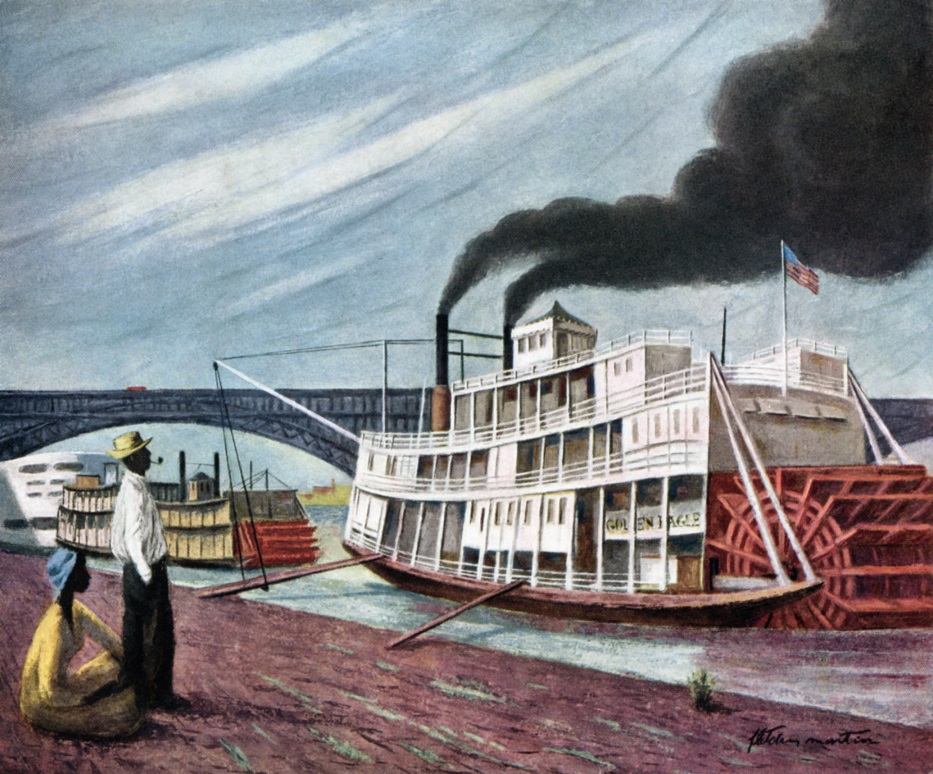
A painting of the GOLDEN EAGLE at the St. Louis levee during the 1940's
Undated painting by well known artist Fletcher Martin of the GOLDEN EAGLE at the St. Louis levee with the Eads Bridge and on the far left, the ADMIRAL, the showboat GOLDENROD and a towboat that pushed the showboat. This was probably painted sometime between 1940 (when the ADMIRAL was launched) and 1947 when the GOLDEN EAGLE sank.
wikipedia.org
Fletcher Martin (April 19, 1904 - May 30, 1979), was an American painter, illustrator, muralist and educator.
He is best known for his images of soldier life during World War II and his sometimes brutal images of boxing and other sports.
He was born in 1904 in Palisade, Colorado, one of seven children of newspaperman Clinton Martin and his wife Josephine.
The family relocated to Idaho and later Washington.
By the age of twelve he was working as a printer. He dropped out of high school and held odd jobs such as lumberjack and professional boxer.
He served in the U.S. Navy, 1922-26. His artistic skills were largely self-taught.
He worked as a printer in Los Angeles in the late 1920s, and as an assistant to Mexican muralist David Alfaro Siqueiros in the early 1930s. He taught at local art schools such as Otis Art Institute.
He won commissions to paint murals for the New Deal's Section of Painting and Sculpture, including Mail Transportation (1938), painted for the San Pedro Federal Building and Post Office in Los Angeles.
Under the WPA he painted a mural study for the Kellogg, Idaho post office titled Mine Rescue (1939).
Local industrialists objected that it depicted the dangers of mining, while officials of the Mine & Smelt Workers Union praised it.
The industrialists prevailed and Martin painted an uncontroversial mural, Discovery (1941), depicting the prospector who founded the town.
The rejected mural study is now in the Smithsonian American Art Museum. Perhaps his most ambitious mural, also done under the WPA, was painted for North Hollywood High School in Los Angeles. Legends of Fernandino and Gabrileno Indians (1937) depicts overlapping scenes of Native American life and ritual, and the world being carried on the backs of giants.
As an artist-correspondent for Life Magazine during World War II, he made hundreds of sketches of U.S. soldier life.
Fourteen of his paintings from the North African campaign were published in the December 27, 1943 issue of Life, and brought him national recognition.
Among these was Boy Picking Flowers, Tunisia, depicting a young GI finding a distraction from war.
He also made illustrations of wartime London and the June 1944 Normandy Invasion.
His paintings often depicted men in conflict. Trouble in Frisco (1938, Museum of Modern Art) shows a brawl between longshoremen witnessed through a ship's porthole.
Many of his most popular works were reproduced as woodcuts, lithographs or silkscreens. After the war he taught at the Art Students League Summer School in Woodstock, New York, settled in the town, and began raising a family. He experimented with abstractionism and began painting naïve images of women and children.
During his career he was a visiting instructor or artist-in-residence at the University of Florida, State University of Iowa, the University of Minnesota, San Antonio Art Institute, and Washington State University. He received prizes from the Los Angeles County Museum of Art in 1935 (for Rural Family) and 1939 (for A Lad from the Fleet); the 1947 Lippincott Prize from the Pennsylvania Academy of the Fine Arts (for Dancer Dressing); and the 1949 Altman Prize from the National Academy of Design (for Cherry Twice).
He was elected an associate of the National Academy of Design in 1969, and a full academician in 1974.
Martin and his fifth wife, novelist Jean Sigsbee Small (married 1962) retired to Guanajuato, Mexico in 1967, where they lived until his death in 1979.
"Lots of students get trapped in the effort to be original. After fifty million paintings have been painted you can see that it is impossible to be highly original. There is always precedent. Who would want to be that original anyway? A better intent is to see that one's work is truly one's own - an honest expression of deep personal feelings. The whole history of art, which can't help but affect one, will be filtered through your own personality to produce a sort of original statement."
- Fletcher Martin.
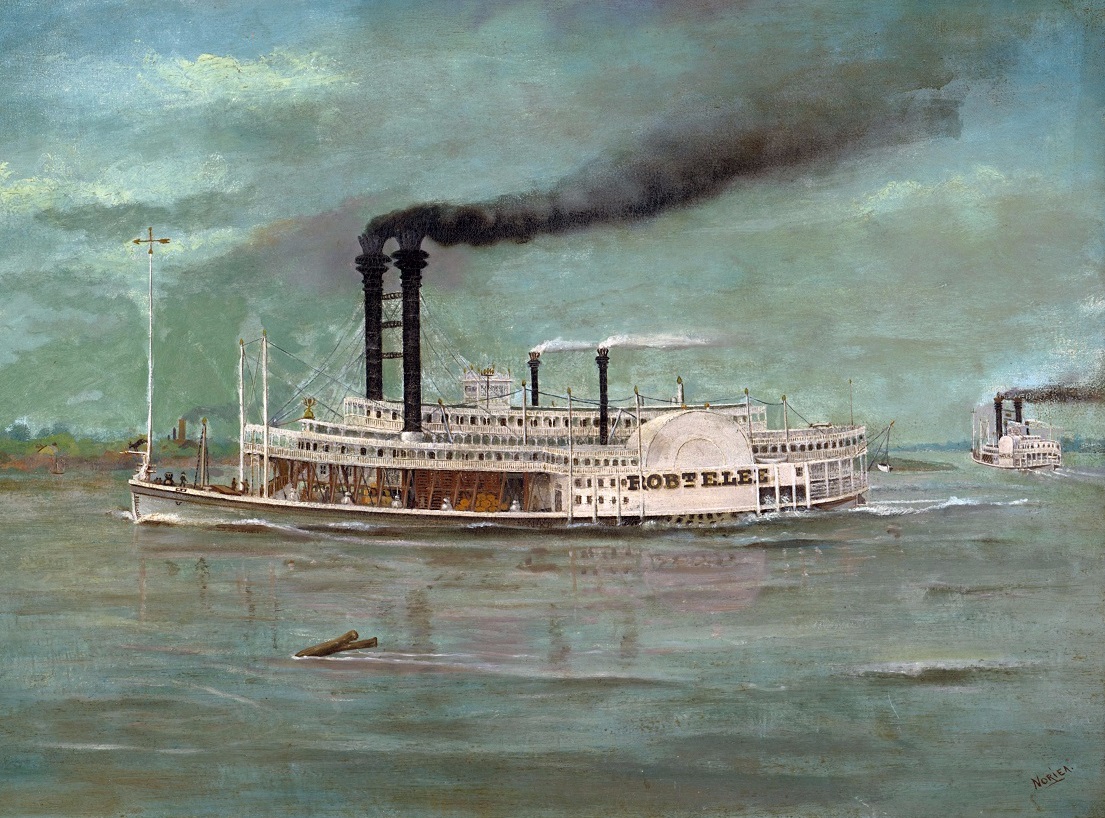
This painting is of the ROB'T E. LEE, by Louisiana artist August Norieri. An enlargement of this painting serves as the backdrop for Jim Waddell's Mark Twain performances at MARK TWAIN CAVE in Hannibal, MO (see the photo below of Jim performing for grade school students).
lsm.crt.state.la.us
August Norieri 1860-1898
The following information courtesy of Neal Auction Company:
The inspired career of August Norieri was tragically ended by his untimely death in 1898 at the age of thirty-eight. Norieri's paintings reflect his fascination with the waterways of New Orleans and the variety of boats that traversed them.
The picturesque steamboats along with the hard working tugboats of the Mississippi River, the sailing boats on Lake Ponchartrain and the steam launch pleasure boats on Bayou St. John all attracted the interest of the artist.
Norieri studied painting with local artist Andre Molinary, participated in the Creole Exhibit of the American Exposition of 1885 and was an active member of the Art Association of New Orleans.
Born into a middle class New Orleans Italian-American family, Norieri's brother Baptiste became a tugboat captain and bar pilot.
internetantiquegazette.com
An image gallery containing thumbnail images of Norieri's steamboat paintings can be seen here:
knowla.org
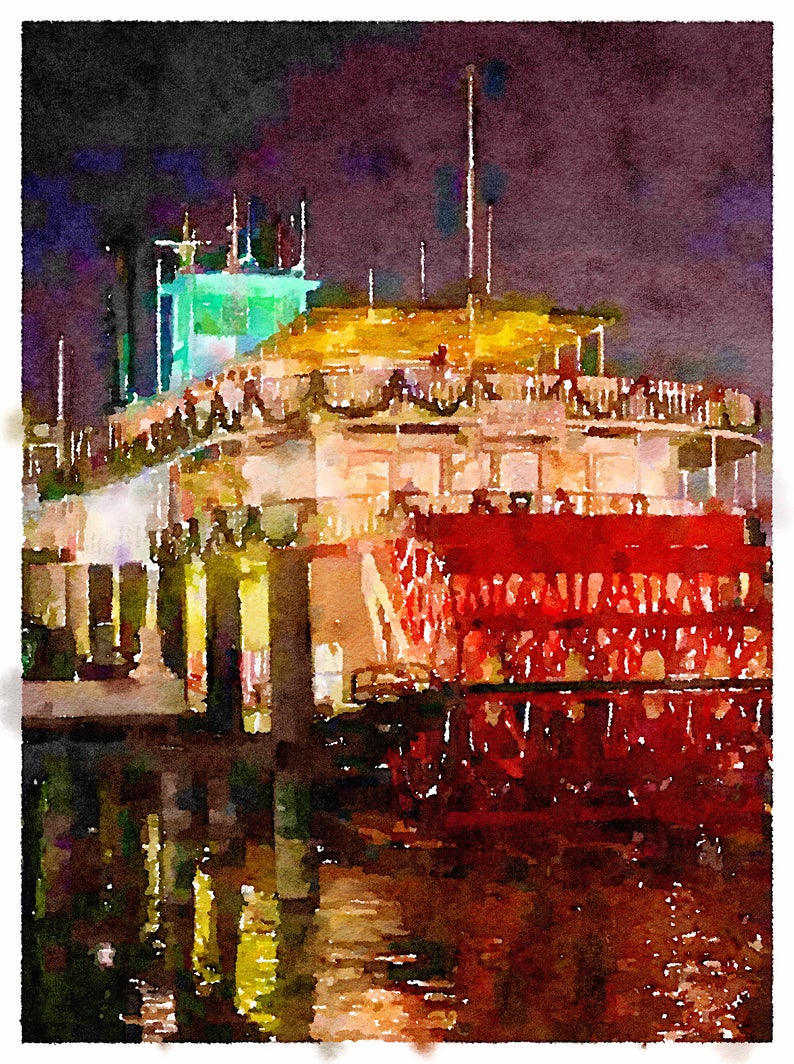
STEAMBOAT NATCHEZ AT NIGHT ON THE MISSISSIPPI AT NEW ORLEANS - IMPRESSIONIST WATERCOLOR
CURRENTLY LISTED ON ETSY . . . THE STEAMBOAT NATCHEZ AT NIGHT ON THE MISSISSIPPI AT NEW ORLEANS IMPRESSIONISTIC WATERCOLOR TECHNIQUE WITH RED INTENSIFIED BY MIXING BEET ROOT WITH WATERCOLOR PAINT
ThePinkRyno
5 out of 5 stars
Riverside Red
$393.95
etsy
Free shipping to United States
Handmade Materials
watercolor, beet root, pastel, acrylic wash, paper
Dimensions
Height: 24 Inches; Width: 20 Inches
Riverside was painted on water color press paper and is aprox 24 x 20 inches the red was created by mixing watercolor and beet root to create a longer lasting brighter red. This is the first painting I have used beet root on. Ships in a tube, ready to frame.
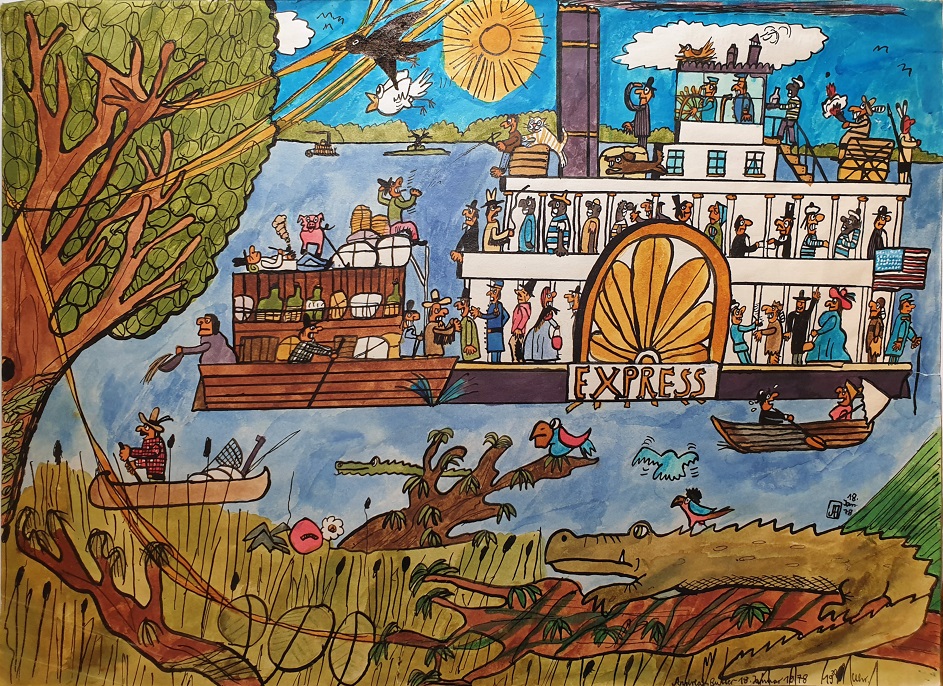
German historian Andreas Butter: one of his early paintings of a Mississippi steamboat
My friend Andreas Butter is an architectural historian in Berlin, Germany. His father was an artist/illustrator who made a series of paintings based on TOM SAWYER that were printed as posters or use in classes teaching the novel to young students. Andreas kindly sent me this photo of his own imaginative work of art of a fantasy steamboat that he painted in 1978 when he was 14 years old. e-mail from Andreas on Thursday, November 28, 2019:
Dave,
Attached is one of my first depictions of a Mississippi steamboat that is a testimonial to my early devotion to the subject. I was 14 and hadn't discovered my world perspective yet. I included many types of folks from the period.
Andreas
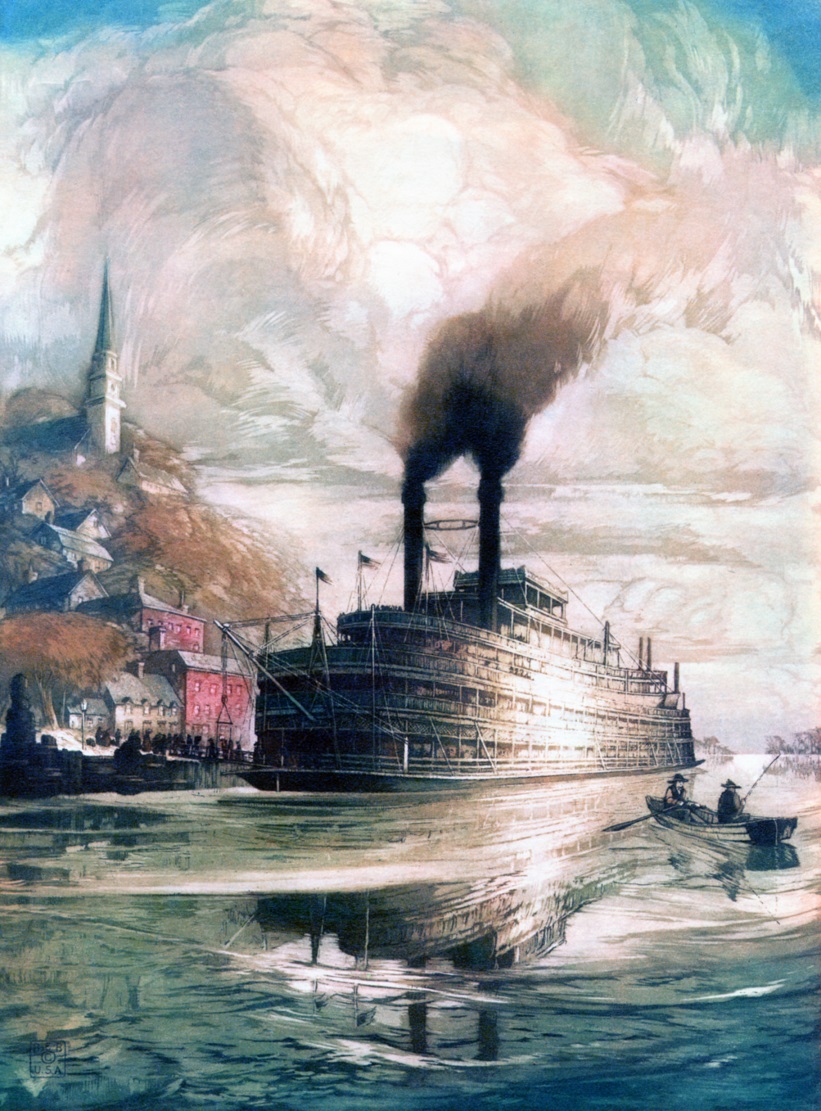
Color Etching "River Queen" by Al Mettel
"River Queen" on the Ohio River by Al Mettel
Calendar Art Talio-Chrome from Color Etching
7.70 x 10.30 inches
Published by
BROWN & BIGELOW
"Remembrance Advertising"
Saint Paul 4, MINNESOTA
varagesale.com
Al Mettel was known for his artistic depictions of churches. His artwork was printed by the hundreds or even thousands by Brown & Bigelow (his employer) each year for promotional calendars and Christmas Season or other holiday give-aways.
He was responsible for a process which reproduced watercolor prints using an old press he modified which he had found during his years in Europe. He passed on in 1957.
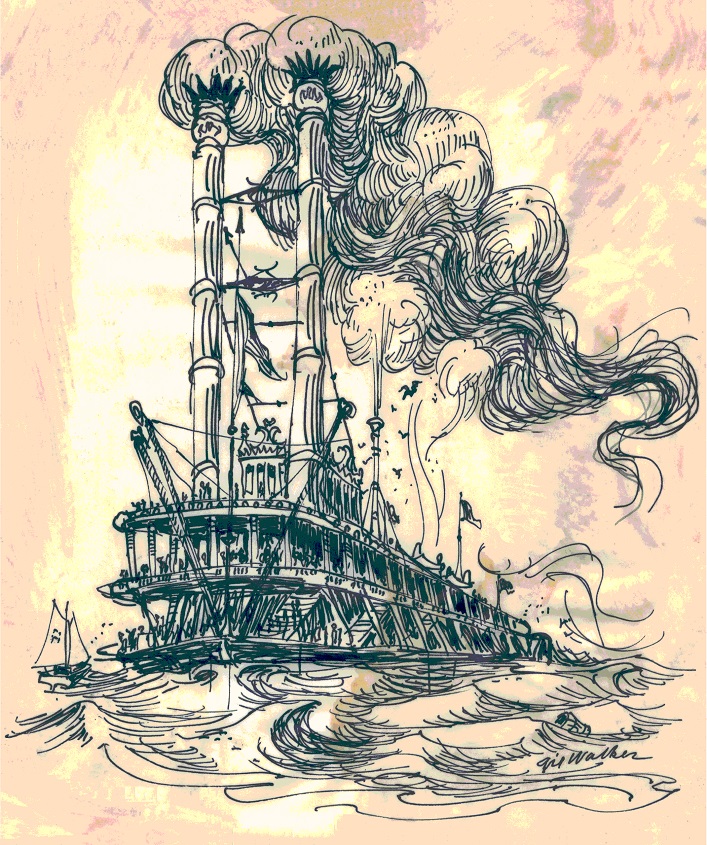
Gil Walker STEAMBOAT Original Pen and Ink Drawing
Scan of an original pen and ink drawing acquired recently of a fanciful steamboat with exceedingly tall stacks that are emitting stylized smoke reminiscent of a fairy tale maiden's luxurious tresses. This scan has been posterized and the texture of the vellum paper that was used make it look like abstract art.
Drawn on vellum 5.50 x 6.30 inches & signed by Gil Walker (who is listed as Gilbert M. Walker on askART.com as having been born in 1927 and still an active artist in New York, known for his work in the historical genre.
Among his works were pen Original Pen and Ink Drawings, used as illustrations to accompany the article "The Siege of Wake Island: An eyewitness account of the World War II battle in the Pacific" written by John R. Burroughs American Heritage magazine. June 1959 Volume 10 Issue 4
americanheritage.com
The Japanese attack on an American military installation began simultaneously with the attack on Pearl Harbor in Hawaii. Footnote: "In the engagement of December 11, the Wake Island shore batteries sank one Japanese destroyer and badly damaged several other warships. Thirty miles southwest of the atoll, the Grumman fighters sank a second destroyer. It was the last time in the Pacific War that coast defense guns repelled an amphibious landing." Wake Island is 2,300 nautical miles southwest of Hawaii in the Pacific Ocean.

With the exception of images credited to public institutions,
everything on this page is from a private collection.
Please contact Steamboats.com for permission for commercial use.*
All captions provided by Dave Thomson, Steamboats.com primary contributor and historian.
